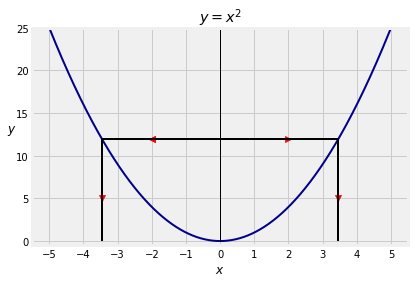Two-to-One Functions
Let X have density fX. As you have seen, the random variable Y=X2 comes up frequently in calculations. Thus far, all we have needed is E(Y) which can be found by the formula for the expectation of a non-linear function of X. To find the density of Y, we can’t directly use the change of variable formula of the previous section because the function g(x)=x2 is not monotone. It is two-to-one because both √x and −√x have the same square.
In this section we will find the density of Y by developing a modification of the change of variable formula for the density of a monotone function of X. The modification extends in a straightforward manner to other two-to-one functions and also to many-to-one functions.
Density of Y=X2
If X can take both positive and negative values, we have to account for the fact that there are two mutually exclusive ways in which the event Y∈dy can happen: either X has to be near the positive square root of y or near the negative square root of y.

So the density of Y at y has two components, as follows. For y>0,
fY(y) = a+bwhere
a=fX(x1)2x1 at x1=√yand
b=fX(x2)|2x2| at x2=−√yWe have used g′(x)=2x when g(x)=x2.
For a more formal approach, start with the cdf of Y:
FY(y) = P(Y≤y)= P(|X|≤√y)= P(−√y≤X≤√y)= FX(√y)−FX(−√y)Differentiate both sides to get our formula for fY(y); keep an eye on the two minus signs in the second term and make sure you combine them correctly.
This approach can be extended to any many-to-one function g. For every y, there will be one component for each value of x such that g(x)=y.
Square of the Standard Normal
Let Z be standard normal and let W=Z2. The possible values of W are non-negative. For a possible value w≥0, the formula we have derived says that the density of W is given by:
fW(w) = fZ(√w)2√w + fZ(−√w)2√w= 1√2πe−12w2√w + 1√2πe−12w2√w=1√2πw−12e−12wBy algebra, the density can be written in an equivalent form that we will use more frequently.
fW(w) = 1212√πw12−1e−12wThis is a member of the family of gamma densities that we will study later in the course. In statistics, it is called the chi squared density with one degree of freedom.
